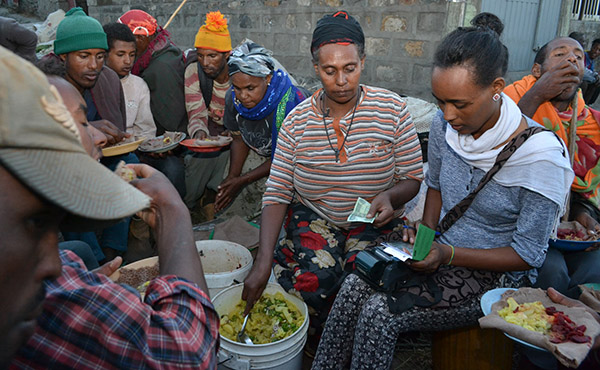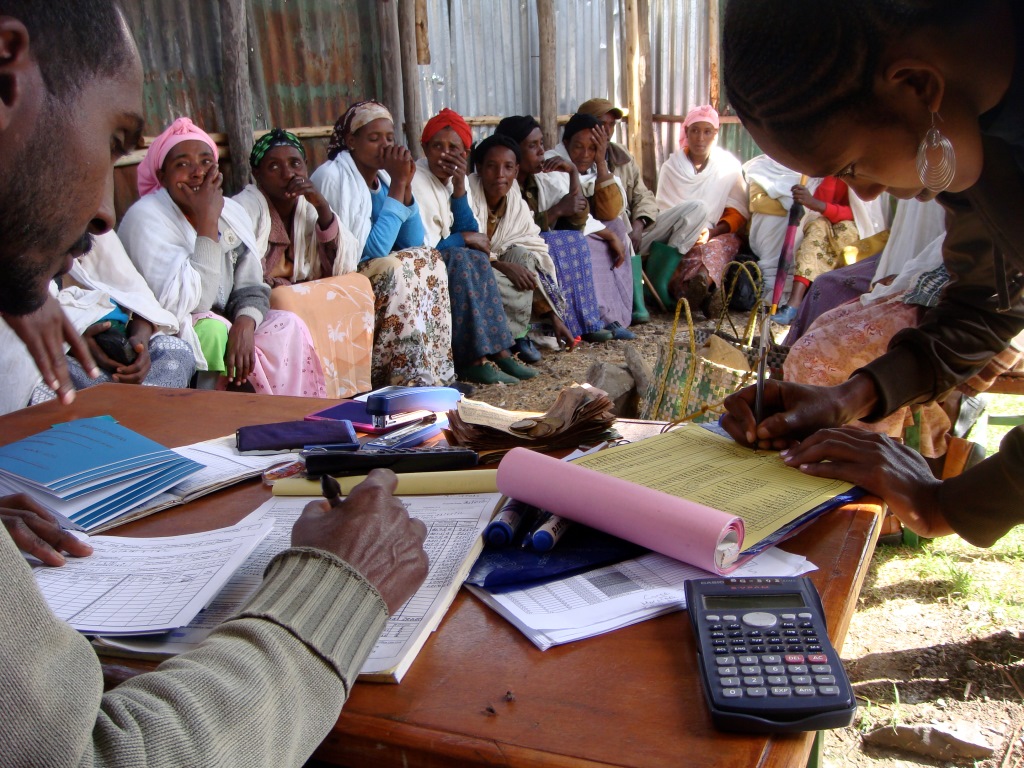In September of this year, e-MFP published the results of a survey that mapped Human Resource Development (HRD) Practices in the Microfinance Sector and highlighted opportunities for acting on those results. This blog is the first in a series of thematic case studies which explore the actions that some survey participants have taken to address each area. The profiled institutions were selected based on the quality of their HR practices and their willingness to share experiences. We are extremely grateful for their time and effort to contribute to this important research.
 The first opportunity for action identified in the e-MFP HR Action Group paper was the importance of alignment between human resource development (HRD) and business strategy. What does this mean? That the HR department should not be just thought of as a support and administrative department but an important player in defining and implementing the institution’s business strategy.
The first opportunity for action identified in the e-MFP HR Action Group paper was the importance of alignment between human resource development (HRD) and business strategy. What does this mean? That the HR department should not be just thought of as a support and administrative department but an important player in defining and implementing the institution’s business strategy.
Aligning HRD and strategy
In 88% of the organizations surveyed, the most senior HR representative reports directly to the Board of Directors, CEO, or most senior management executive. Yet, a lack of alignment between HRD and business strategy emerged from the survey as one of the top three factors hindering performance.
In the words of Nancy Camey, People and Culture Manager at VisionFund Guatemala, “Having a seat at the decision-making table is important, but it’s not enough. Once you’re there, you have to contribute to the business. You have to make investments in HR worthwhile.” Teshome Dayesso, General Manager of Buusaa Gonofaa in Ethiopia, highlights another aspect of the challenge, “You have to align HR processes for tomorrow’s strength instead of today’s dominant product.”
It’s not easy. Buusaa Gonofaa has tried delivering new products through specialized staff and infrastructure as well as through existing staff with a diversified portfolio and it has struggled to achieve scale under both approaches despite strong market demand. This year, Mr. Dayesso is responding with changes in the way people are managed.
He’s not alone. HRD is evolving in all of the case study institutions to better align with business strategy. Described below are some of the actions being taken.
Minding the gap
One of the most common ways to contribute to the business is for the HR team to focus on the key performance indicators (KPIs) or milestones that the organization wants to achieve during a specific period, find the performance gap (what is missing to be able to achieve that target), and then recruit or develop talent to close that gap. According to Salome Kvakhadze, Head of Talent Development and Management at Crystal in Georgia, this approach works even during a crisis like the COVID-19 pandemic. “We shortened our planning cycle from five years to one, and we’re setting KPIs quarterly instead of annually, but the basic process is the same.”
Ms. Kvakhadze makes another good point about gaps. Typically, HR is expected to address gaps in knowledge, skills, and attitudes among employees. But if the business strategy is to digitalize, then the HR function (like every other function or department in the organization) must ask itself, “What processes can we digitalize?” It needs to look for gaps between its own performance and the aspirations of the business.
Becoming a strategic advisor and a business partner
A less common but no less strategic way to contribute to the business is to prepare and support managers throughout the organization to carry out their HR role. In the words of Joy Santos, Vice President of Operations at ASKI in the Philippines, “The HR role is not just the role of the HR department. Line managers have a crucial role to perform…we provided training to our managers especially on crucial decision points in managing Human capital.”
VisionFund Guatemala’s Nancy Camey expands on this: “Before, [the People and Culture Department] was just a traditional administrative department, dealing with contracts, disciplinary processes, the dissemination of information, but now we are advisors to the areas – to the CEOs, to the business managers, to the COOs,” she says. “Now we have become a business partner. They take us into account for the important decisions, and that’s where it makes a difference.”
Julissa Castillo, HR Manager at FINCA Guatemala puts it yet another way, “Human resources is in the middle. On the one hand, we have to understand the objectives of each of the business areas, and on the other hand, we have to understand employees’ needs and feelings, so that we can help the two mix together in a way that produces results for the areas and also loyalty from our employees.”
Developing HR roles from within
Having the most senior HR representative at the decision-making table helps keep the HR team well-informed about business priorities but having HR professionals with operational experience helps the HR department to understand the business and employees’ needs. Fermin Sanchez, CEO of FINCA Guatemala, thinks this is critical: “Julissa has been with us for 14 years. She came from being a cashier at the branch and is now our Human Resources Manager, so she has a lot of knowledge. In the microfinance sector, you don’t always have to hire a corporate HR representative. What you need is someone who really understands the requirements in the field.”
All but one of the MFIs interviewed has a management development program that aims, in part, to increase awareness of managers’ HR roles and to strengthen their capacity to carry out those functions.
Linking rewards and remuneration to business priorities
The adage, “What gets measured gets done,” doesn’t always hold true, but tying rewards – be they financial or non-financial – to the achievement of business objectives is a strategy that all case study institutions pursue. Five out of the seven have created tools to guide managers in the performance evaluation process so that it’s easier to stay focused on business priorities.
The process seems straightforward for financial goals, but institutions struggle when it comes to social goals. Survey respondents with a double bottom line (i.e., those pursuing financial and social objectives) incentivize financial goals much more often (82%) than social goals (48%). Even among organizations that are committed to achieving social goals only, financial goals are incentivized twice as often (77%) as social goals (38%). The percentages among case study MFIs follow a similar pattern, suggesting that more can be done to strengthen alignment in this area.
Segmentation
The MFIs interviewed use segmentation in a variety of ways, one of which is to differentiate between those parts of the organization that are delivering well against business priorities and those that are not. At Buusaa Gonofaa, branches were recently divided into three categories according to their performance against business objectives (above average, average, and below average). The branches in each category were then brought together to discuss what is working, what is not, and what can be done in response. As will be covered in the fourth piece in this series, this way of splitting the discussions by branch category played an important role in enabling branches to take ownership of their situation and to contribute more proactively to plans for the coming period.
FINCA Guatemala segments in a similar fashion, but at an individual level. All managers are asked to conduct a quarterly talent review during which they divide the people they supervise into categories by performance (high, middle, low) and how critical their work is to the business. For critical employees, managers are asked to develop a succession plan. The review facilitates a more targeted approach to performance management, and it helped the organization make strategic and timely HR decisions during the COVID-19 crisis.
Knowing the cost of turnover
Many would argue that employee retention is HR’s most important function, but not all employee turnover is bad. Ms. Kvakhadze notes that Crystal periodically goes through a transformation process and does what it can to prepare employees for inevitable changes. But there are, of course, some who are not happy with the changes and decide to leave. VisionFund Guatemala sets a target retention rate that is above the global average, but slightly below the local market norm. It can do this because it knows that beyond a certain point, spending additional resources to retain employees is counter productive, and valuing employees’ experiences within the organisation at all levels, including development, growth, and benefits, is just as important.
The cost of turnover varies, of course, depending on the position being vacated and the amount that has been invested in employees relative to the value they have created. In Benin, Mutuelle pour le Développement à la Base (MDB) adjusted its recruitment and onboarding processes after it measured the cost of turnover and saw that it was investing too much in new recruits early on, before they had decided that the job was a good fit, and before they started generating value for the organization. Its new approach uses internships to screen employee candidates before providing higher compensation and greater development opportunities.
 Defining alignment
Defining alignment
Connecting HR functions and business strategy in clear and visible ways can also help strengthen alignment. Crystal did this by creating what it refers to as “regulations” that describe the role, objectives, and job descriptions for each department, including HR. Among other things, these regulations articulate how HR is expected to contribute to the business.
At VisionFund Guatemala, HR’s contribution to business strategy is made visible in the organization’s objectives. In its current strategic plan, two objectives speak directly to the role of HR. One of these reads, "To develop, in a phased manner, distinctive capabilities in all areas and collaborators to implement the culture strategy focused on agility and change management.”
Providing cultural stewardship
At VisionFund Guatemala, the HR department is called “People and Culture,” reflecting the organization’s belief that culture is important and is shaped by its people. Ms. Camey explains, “You have to be incredibly intentional about creating the culture you want. Having the support and buy-in of everyone truly thinking about it, talking about it, and making sure everyone is taking concrete steps to live it is key.” This approach to doing business helps differentiate VisionFund Guatemala in the market and makes it easier to attract and retain people who share its priorities.
When people in an organization communicate easily and effectively, plans are easier to implement, and problems are more likely to be identified as they arise. When people trust each other, they’re more likely to collaborate to find solutions. When they don’t, the resulting friction can hinder both the design and implementation of business strategy. Ms. Camey identified communication and trust as being critical to the success of HR’s relationships with other parts of the business, but cultural elements such as these can impact every function in an organization.
Perhaps for this reason, more than half of the case study institutions have overtly tasked the HR function with nurturing and protecting their culture. At Bank Arvand in Tajikistan, it all starts with recruiting people who share the organization’s values. Situational questions are asked during the screening process to gauge the values that guide people’s behavior; recruiters don’t just listen to what candidates say they value.
Controlling the focus of outsourced initiatives
Two-thirds of survey respondents do not outsource HR activities because they believe it is important to carry out all HR functions internally. Several of the case study MFIs do outsource, and they claim the key to success is getting and keeping the external parties focused on the MFI’s goals. The purpose of a training initiative, for example, shouldn’t be simply to transfer knowledge in a particular area. It should enable the people involved to use that knowledge to tackle a particular problem or achieve a target.
This year, FINCA Guatemala worked with an external company to develop a new leadership program for middle management. Its first step was to meet with several providers, explain its goals, compare their responses, and then select one company with which to work. After selection, the HR team held a kickoff meeting with the external team to restate the organization’s goals and needs. The external team returned later with recommendations for ten different abilities that could be developed during the program, and FINCA Guatemala chose the four that it thought would yield the results it needed. The program is now being evaluated based on the extent to which those four abilities are actually developed. This relevance of measuring the results of HRD investments will be further explored in the second part of this case study series, Is HRD worth it? How seven MFIs are measuring the cost-effectiveness of their HR investments.
Photos: Buusaa Gonofaa


Leave a comment